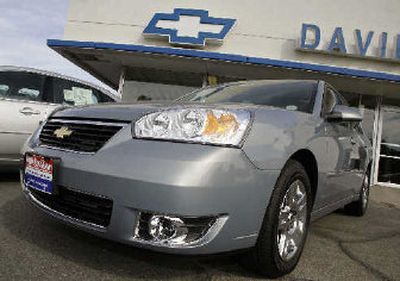Report: U.S. automakers would benefit from common platforms

TROY, Mich. — Domestic automakers make an average of $2,400 less per vehicle than their Japanese rivals because of high labor benefit costs, less-efficient purchasing and manufacturing procedures, and a weak yen, a study released Monday said.
The report by the Harbour-Felax Group, a widely respected industry consulting firm based in suburban Detroit, paints a grave picture for General Motors Corp., Ford Motor Co. and DaimlerChrysler AG’s Chrysler Group versus their Japanese automakers.
The domestic automakers must quickly reduce their labor and manufacturing costs or they may not be in business over the long term, said company president Laurie Harbour-Felax.
“If they don’t do this, they have their own problems to deal with in terms of long-term viability,” she said.
The key to making more money is common components and car underpinnings used on multiple models, similar to what Toyota Motor Corp., Honda Motor Co. and Nissan Motor Co. already are doing, said company founder Jim Harbour.
By using common platforms, body architectures and components, Toyota has saved approximately $1,000 per vehicle over the last five years, the report said. In addition, when fewer unique parts are needed for each vehicle, quality improves, reducing warranty costs, it said.
Another major contributor to the gap is revenue per vehicle. On average, domestic automakers take in $21,597, 11 percent less than the average revenue of Japanese automakers, which collect $24,289 per vehicle, the report said. The authors attributed that disparity to steep discounts that domestic manufacturers use to fuel sales, as well as discounts for rental and other fleet sales, which average 25 percent of total domestic sales.
The study also pointed to labor issues, including generous health care benefits and contracts that allow workers to continue collecting wages when there is no work for them, as a major factor in the profit gap.
GM, Ford and DaimlerChrysler are making progress in common components, and they must address the labor and health care cost issues in 2007 negotiations with the United Auto Workers, Harbour-Felax said.
“I personally don’t think one of them is going to go away,” said Harbour-Felax, who is Jim Harbour’s daughter.
The company closest to operating like the Japanese is General Motors, followed by Chrysler, then Ford, Harbour said.
Based on 2005 numbers, GM lost $1,271 per vehicle in North America, while DaimlerChrysler made $144 and Ford lost $451, according to the report. Nissan made $2,135, while Toyota made $1,715 and Honda made $1,259.